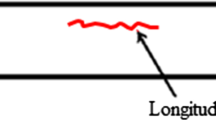Abstract
Detecting fatigue cracks in hydraulic turbine runners is costly, as it requires stopping the unit, emptying it of water and accessing the runner for inspection. Thus, an alternative way based on monitoring the changes of the structural modal response induced by the formation and growth of a crack was investigated. To do so, the crack propagation induced by a resonance was numerically predicted and experimentally machined on a disk-like structure that resembles a Kaplan turbine runner. The analysis of the results shows how the different stages of the fatigue crack growth can be monitored based on the change of the natural frequencies and mode shapes of several specific modes. Based on the obtained results, a structural health monitoring system is being designed to monitor the turbine runner modes of vibration without the need to stop and inspect the unit.
Similar content being viewed by others
Abbreviations
- f :
-
Natural frequency of a mode shape
- k :
-
Modal stiffness of a mode shape
- m :
-
Modal mass of a mode shape
- k’:
-
Critical stiffness
- f crit :
-
Critical natural frequency of a mode shape
- L crit :
-
Crack critical length
- f numerical :
-
Natural frequency obtained through the numerical modal analysis
- f experimental :
-
Natural frequency obtained through the experimental modal analysis
References
AFC4Hydro, Active Flow Control System for Improving Hydraulic Turbine Performances at Off-design Operation, AFC4Hydro (2020), Available: https://afc4hydro.eu/, Accessed on February 15 (2022).
A. S. Bouboulas and N. K. Anifantis, Vibration analysis of a rotating disk with a crack, International Scholarly Research Notices, 2011 (2011) 727120, https://doi.org/10.5402/2011/727120.
F. Hille, D. Sowietzki and R. Makris, Luminescence-based early detection of fatigue cracks, Materials Today: Proceedings, 32 (2020) 78–82, https://doi.org/10.1016/jmatpr.2020.02.338.
M. Zhang, D. Valentín, C. Valero, M. Egusquiza and E. Egusquiza, Failure investigation of a kaplan turbine blade, Engineering Failure Analysis, 97 (2019) 690–700, https://doi.org/10.1016/j.engfailanal.2019.01.056.
M. Zhang, D. Valentín, C. Valero, A. Presas, M. Egusquiza and E. Egusquiza, Experimental and numerical investigation on the influence of a large crack on the modal behaviour of a Kaplan turbine Blade, Engineering Failure Analysis, 109 (2020) 104389, https://doi.org/10.1016/j.engfailanal.2020.104389.
Z. Mróz, A. Seweryn and A. Tomczyk, Fatigue crack growth prediction accounting for the damage zone, Fatigue and Fracture of Engineering Materials and Structures, 28 (2004) 61–71, https://doi.org/10.1111/j.1460-2695.2004.00829.x.
X. Ayneto Gubert, Fatigue of Automotive Components and Structures, Design, Development and Diagnosis, Idom (2007).
Y. Luo, A. Presas, Z. Wang and Y. Xiao, Operating conditions leading to crack propagation in turbine blades of tidal barrages. Influence of head and operating mode, Engineering Failure Analysis, 108 (2020), https://doi.org/10.1016/j.engfailanal.2019.104254.
P. Avitabile, Experimental modal analysis: A simple non-mathematical presentation, Sound and Vibration, 35 (2001) 20–31, https://doi.org/10.1002/9781119222989.ch1.
K. P. Mróz and Z. Mróz, On crack path evolution rules, Engineering Fracture Mechanics, 77 (11) (2010) 1781–1807, https://doi.org/10.1016/j.engfracmech.2010.03.038.
Acknowledgments
This work was supported by the European Union’s Horizon 2020 research and innovation program under grant agreement number 814958.
Author information
Authors and Affiliations
Corresponding author
Additional information
Xavier Sánchez Botello received his double Master’s degree in Industrial Engineering and in Robotics and Automatic Control from Universitat Politécnica de Catalunya (UPC) in 2021. He is currently a researcher in the Barcelona Fluids & Energy Lab (IFLUIDS), and he is participating on the WP3 of the AFC4Hydro European project.
Adolfo de la Torre is an Industrial Engineer specializing in management. He is currently working in one of the biggest companies of energy distribution in Spain called Endesa, in the Department of Infrastructure and Networks. Regarding the knowledge about the topic, his final thesis consisted in analyzing the effect of fatigue on structures (basically, disks) subjected to external and variable loads.
Rafel Roig received his M.S. in Industrial Engineering from Universitat Politècnica de Catalunya (UPC) in 2017. From 2017 to 2020, he was working as design engineer. In 2020 he joined the Barcelona Fluids and Energy Lab (IFLUIDS) as Ph.D. candidate. His research interests include structural dynamics, fluid structure interaction, finite element model and experimental testing.
Esteve Jou, a member of the Fluid Mechanics Department in the UPC, obtained the Industrial Engineer degree in ETSEIB in 1993. In 1999 he obtained the Ph.D. He teaches compulsory subjects like Fluid Mechanics and Hydraulic Machines, and other optional subjects like Aerodynamics in vehicles. Dr. Esteve Jou’s interests comprise the vibrational analysis and diagnosis in hydraulic systems and machinery.
Oscar de la Torre received his Ph.D. in Industrial Engineering from Universitat Politècnica de Catalunya (UPC) in 2013. His research continued in Ireland, UK and Spain. He is currently working as R+D offshore engineer in Floating Power Plant. His research interests include structural dynamics, fluid structure interaction, experimental testing, and renewable energies.
Javier Ayneto holds a degree in industrial engineering from the UPC (1982) and a Ph.D. in Industrial Engineering from the same university (1988). He is currently director of the Department of Strength of Materials and Structures in Engineering. His research work focuses on numerical simulation, experimental mechanics, especially in the field of fatigue and durability.
Xavier Escaler is Associate Professor in the Fluid Mechanics Department of the Barcelona School of Industrial Engineering (ETSEIB) at UPC. He is the leader of the Barcelona Fluids and Energy Lab (IFLUIDS) working in the measurement of flows and structures in hydraulic systems and machines, the development of advanced signal processing methods, the diagnostics of dynamic fluid problems, the use of CFD for the numerical simulation of cavitation and coupled fluid-structure systems, the modelling of piping systems with one-dimensional models and the on-line and off-line monitoring of rotating machines for predictive maintenance and condition monitoring.
Rights and permissions
About this article
Cite this article
Sánchez-Botello, X., de la Torre, A., Roig, R. et al. Experimental and numerical study on the detection of fatigue failure in hydraulic turbines. J Mech Sci Technol 37, 4949–4955 (2023). https://doi.org/10.1007/s12206-023-0902-y
Received:
Revised:
Accepted:
Published:
Issue Date:
DOI: https://doi.org/10.1007/s12206-023-0902-y




